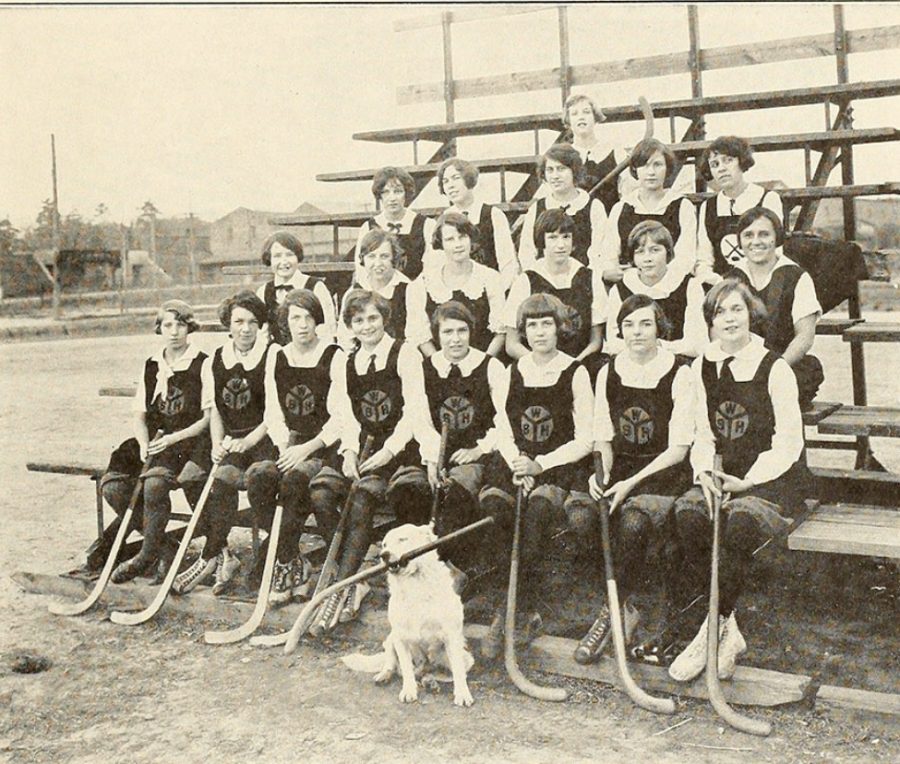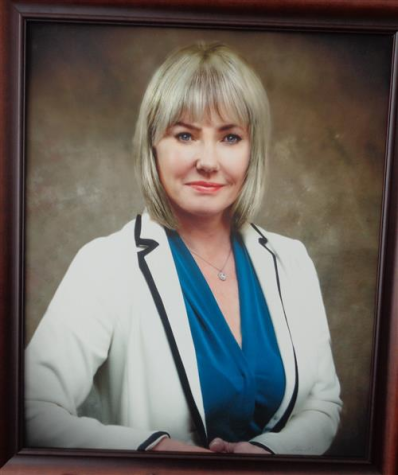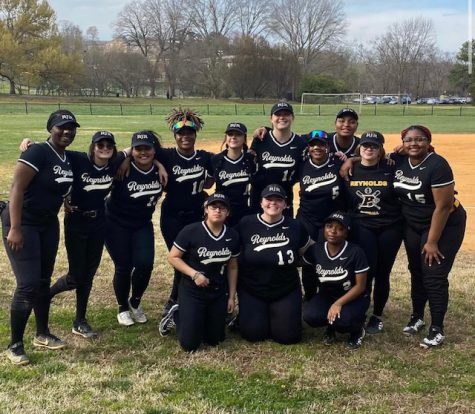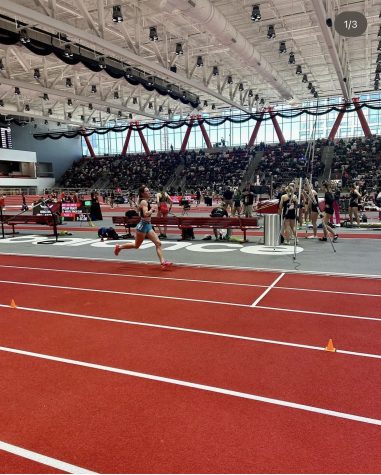Changing the game
Photo provided by 1926 Black & Gold yearbook.
The 1926 state championship-winning women’s hockey team.
April 22, 2023
When you walk into Bryson Gym, you will probably notice the banners hanging from the rafters and trophies sitting in their cases, both silently celebrating RJ Reynolds High School’s sports achievements from the past century. What you will not see, however, is the championships missed, and the banners never hung for women’s teams that did not yet exist or that received little funding and support. While men’s sports have thrived at Reynolds since the school’s early years, women’s teams have had more difficulty making their way into the spotlight.
When Reynolds was founded in 1923, teams were mostly limited to young men, though a few women’s teams managed to thrive early on in this male-dominated environment. In the 1925 Black & Gold yearbook, girls wrote about each available sport, describing its benefits and how girls enjoyed it during the year. At the time, soccer was popular for everyone to play.
“From the characteristics of the game, most of us would gather that it is a game for boys, but the girls are as interested as are the boys,” Verda Morton (Class of 1925) wrote about recreational soccer at the school.
As Morton explained, even when most might assume the girls may not have been interested, they were. These young women were already pushing for their place in high school athletics, and they wanted a real team of their own, which was sadly not created until decades later.
Another example of this is the 1926 women’s field hockey team. This team won a state championship title, though they only played five games in their regular season. Even when there were not many other teams around, the Reynolds team was able to have a season and reach a terrific victory that helped prove their competence in athletics. The field hockey teams of today mirror this success with their rigor and hard-fought wins. The 2006 team specifically reached the same achievement with their state title.
Despite these early successes, female athletes and teams were not seen as or treated equally to men until much later in the 20th century. These relatively small and scarcely supported women’s teams continued for a long time alongside men’s teams that received more funding and more recognition. But in 1972, this all changed with the passage of a groundbreaking federal law— Title IX.
“Title IX really is what changed everything,” Athletic Director Brad Fisher said. “The purpose of Title IX is to make sure that girls have the same equal access as boys, either through facilities or through participation… That has really helped change female athletics for the past couple of decades.”
Though many women’s teams existed before the passage of Title IX, the law ensured equal opportunities everywhere. Consequently, the ’70s and ’80s at Reynolds marked the creation of many new women’s teams, including soccer, softball, track, and tennis.
Once these teams existed, they almost immediately jumped to immense success. Early soccer teams ran undefeated 1982 and 1983 seasons thanks to star player and 1983 McDonald’s All-American Allison Lippard Morris. Morris was arguably the most successful Reynolds athlete, female or male, during her time at Reynolds. She showed other girls the athletic success they could have. In 1973, volleyball drew more athletes to tryouts than any women’s sport ever had, and in 1974, girl’s tennis won a conference championship.
Intramural sports also gained popularity with female athletes in the ’70s. This opportunity allowed even more girls to participate in athletics, even if they did not have much time to commit or just wanted to exercise. As more girls joined sports, the idea that women belong in athletics was embedded deeper into Reynolds’s culture.
Later, in 1997, the Reynolds women’s tennis team shot to success. During the season, they were ranked 18th in the nation by USA Today, a feat with which no Reynolds team to that point could compare. This team was 12-0 for the season, and those girls brought national attention to Reynolds.
In 2005, Athletic Director Brad Fisher started working at Reynolds and took action to bolster the women’s athletic program. Early on, he relocated field hockey games from an old, beat-up field to Bolton, where the men’s soccer team had been playing. Also, Bryson Gym had no women’s locker room at the time. To give teams like volleyball and women’s basketball a place to change and meet, Fisher switched one of the men’s rooms to a women’s locker room.
“The girls that are playing now have come in, and… to them, it’s always been that way because that’s all they’ve known,” Fisher said. “But before 2005, our field hockey team was playing in a cow pasture, and girls were changing in a different building.”
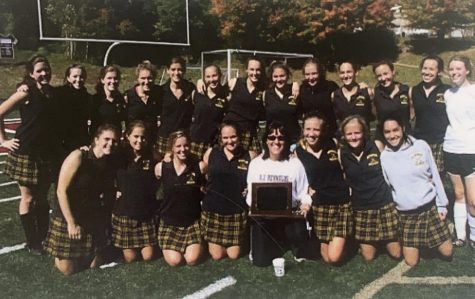
These changes not only made female athletes’ lives easier, but they also helped the teams feel more significant in the eyes of the administration. This sense of importance and support from the school’s leadership is essential for teams to thrive.
Students have also increased their support for women’s teams since Fisher came to RJR. While the men’s football team may still have the most student attendance at games, when women’s teams are successful, students and faculty alike want to attend and watch them succeed. Chandler Wagner (Class of 2013), an extremely successful female athlete at Reynolds and afterward, is an example of this. Wagner played two sports in both the fall and spring seasons and one in the winter, and she brought crowds to games because of her exceptional abilities.
“She was an all-around outstanding athlete,” Fisher said. “…People would come to games to see Chandler.”
Wagner herself felt highly supported by the athletic leadership and the school as a whole.
“I rarely felt that my teams were a lower priority than the male equivalents,” Wagner said. “My experience was that student body support for a team was primarily related to the success the team was having rather than the gender of the team.”
Wagner’s experience is an excellent example of how women’s athletics at Reynolds have transformed since they began. Early on, many people did not care or even refused to see women play, and in her experience, gender was not a factor in fans’ attendance. Even in the ten years since Wagner’s time at Reynolds, women’s teams have found more ways to prosper and have received more recognition.
Alongside these successes, female athletes continue to face inequity in the Reynolds athletic department. One aspect of this is the many social media posts about Reynolds sports.
“There’s more on social media about the boy’s games,” co-captain of the women’s lacrosse team Piper Leinbach said. “The boys are always the first picture in the Rowdies’ posts.”
The lacrosse team has also experienced issues with the amount of support and choice they receive from athletic leadership.
“When our Tabor game was getting rescheduled, we didn’t even get to pick the date, the time, the location—nothing of that was our pick,” co-captain of women’s lacrosse Emma Gray said. “It was all based on the boys and what they wanted to do.”
Even though true equality has not been achieved, progressions like Title IX and improvements in the culture at our school have changed the game for girls playing at Reynolds today. The struggles and experiences of earlier women at Reynolds have ultimately helped today’s female athletes begin to get what they deserve. Women today continue their work in breaking down these barriers. Hopefully, someday soon, girls will be able to walk into Bryson, see just as much appreciation for women as there is for men, and feel inspired to find a field, pick up a stick, or join a team, because they know that women before them did.



